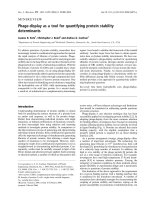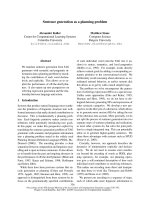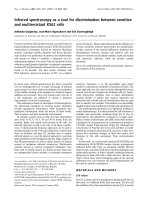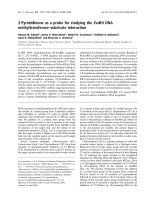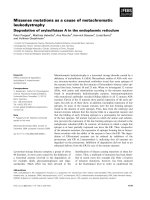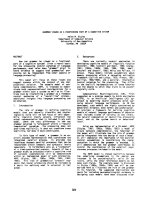Báo cáo sinh học: " Sperm dumping as a defense against meiotic drive" doc
Bạn đang xem bản rút gọn của tài liệu. Xem và tải ngay bản đầy đủ của tài liệu tại đây (110 KB, 3 trang )
Minireview
SSppeerrmm dduummppiinngg aass aa ddeeffeennssee aaggaaiinnsstt mmeeiioottiicc ddrriivvee
Tom Price*, Zenobia Lewis
†
and Nina Wedell*
Address: *Ecology and Conservation, School of Biosciences, Cornwall Campus, Penryn, Cornwall, TR10 9EZ, UK.
†
Graduate School of Environmental Science, Okayama University, Okayama 700-8530, Japan.
Correspondence: Tom Price. Email:
Meiotic drivers are genes that subvert the normal rules of
inheritance to ensure that they are present in more than
their fair share of gametes in the next generation [1]. For
example, the driver sex-ratio (SR) in the fruit fly Drosophila
simulans is an X chromosome that is present in all the sperm
produced by male carriers, thus causing SR males to
produce only daughters (Figure 1). This is because sperm
carrying the Y chromosome in these males fails to develop
properly. Early genetic analyses suggested that these drivers
should increase in frequency in the population, as male
carriers pass the driver on to all their offspring [1,2]. The SR
was also predicted to outcompete normal X chromosomes
because of the increased number of offspring in the popu-
lation receiving the driving X. Eventually, the driver should
reach such a high frequency that the population would
consist entirely of females - and would go extinct. In reality,
drivers do not seem to spread to fixation. In wild popula-
tions, drivers are often found at a low but stable frequency,
and in laboratory populations SR and other drivers are
usually outcompeted by non-driving chromosomes [2].
Furthermore, experimental studies have shown that this
failure to spread is probably caused by reduced competitive
ability of driving males’ sperm [3].
In males carrying SR, for example, the failure of the sperm
that carry the Y chromosome could reduce the total amount
of functioning sperm produced. This in turn might reduce the
amount of sperm that the male transfers to a female. If a
female mates with more than one male, the sperm will mix
inside her and compete to fertilize her eggs, and the male
transferring the most sperm is generally expected to fertilize
the majority of eggs [4]. Male carriers of sex-distorter genes,
whose sperm production is limited by the killing of non-
driving sperm, may be poor sperm competitors as a result [5].
Previous work has indeed found that carriers of meiotic
drivers are generally poor sperm competitors compared with
non-carrying males [3], and this is assumed to be due to
direct competition between sperm, with males that transfer
more sperm being more successful. A recent paper by
Angelard and co-workers [6], published in BMC Evolutionary
Biology, now challenges this assumption, by showing that
female response to sperm quantity may be more important
than direct competition between the sperm.
Angelard and her colleagues investigated SR drive in D.
simulans. They mated virgin females to either a male carrying
AAbbssttrraacctt
Sperm from
Drosophila simulans
that carry a sex-ratio distorter is preferentially lost from
females’ sperm-storage organs. This suggests that sperm dumping is a major factor
affecting sperm competition in this species, and may have evolved in response to sex-ratio
distorters.
Journal of Biology
2009,
88::
6
Published: 20 January 2009
Journal of Biology
2009,
88::
6
The electronic version of this article is the complete one and can be
found online at />© 2009 BioMed Central Ltd
the SR driver or a normal male. They then removed and
counted the sperm both in the uterus, indicating the amount
transferred, and in the female’s sperm-storage site, indicating
the amount stored by the female for use in fertilizing eggs.
Males that carried the SR driver were found to transfer half
the number of sperm of normal males. After 24 hours, the
proportion of a male’s sperm in storage was the same,
irrespective of male genotype. However, four days after
mating, there was a significantly greater drop in the number
of stored sperm from males carrying the SR driver (compared
with that from normal males), suggesting that the ‘driving’
sperm was preferentially discarded by females. The authors
confirmed that this effect was not simply due to a higher
death rate of SR sperm in storage by assaying sperm mortality
rate. Although SR sperm did show a higher mortality rate
than normal sperm, the difference was not large enough to
account for the observed decrease in sperm numbers.
The authors could not determine directly whether the
removal of SR males’ sperm was due to a specific response
by females to sperm carrying the SR driver, or was simply a
response to receiving small ejaculates. There is little
previous evidence that females can detect meiotic drivers in
sperm, and it therefore seems likely that D. simulans females
were responding to the significantly smaller ejaculates
transferred by SR males. This possibility could be tested in
future studies by using multiply mated normal males,
which transfer smaller ejaculates.
Angelard and co-workers also allowed females to remate
with a second male, allowing either sperm transfer or inter-
rupting the mating to allow seminal fluid but not sperm to
be passed to the female. Seminal fluid contains a wide range
of proteins that directly affect sperm competition and sperm
survival [7]. Previous work, mostly on the closely related D.
melanogaster, suggests that both sperm and accessory fluid
have strong impacts on the sperm stored from the first
mating [7]. In Angelard’s study, however, the second mating
did not affect the release of sperm from the first mating,
whereas the genotype of the first male had a very strong
impact [6].
It has been suggested that female responses to meiotic
drivers may play an important role in preventing their
spread through populations. For example, females could
remate more often when there is a risk of mating with SR
males, thereby promoting sperm competition that reduces
the paternity of SR males [8]. Although sperm dumping has
previously been suggested as a major factor affecting the
outcome of sperm competition in D. melanogaster [9], this is
the first time it has been proposed to directly regulate the
spread of meiotic driving genes. Indeed, this work raises the
possibility that the preferential dumping by females of
sperm from small ejaculates might have evolved as a way to
reduce the risk of driving males fathering offspring. There
are other possible explanations, however. For example,
sperm loss could be a by-product of selection for something
else; conditions in the female sperm-storage organ are
potentially damaging to sperm, and large ejaculates may be
better able to buffer against female spermicide and hence
survive longer. Certainly the uterus of a female Drosophila is
a very unfriendly environment for sperm, possibly as a side
effect of mechanisms for preventing infection taking hold in
the vulnerable reproductive tract [10].
Angelard et al. [6] used strains of D. simulans that had been
maintained in the laboratory for many generations, and
throughout this time adult females and males were kept
together. As a result, females were unlikely to ever run out
of sperm. It would be interesting to examine whether
differential loss of sperm also occurs in wild populations
harboring meiotic drivers. In some populations, sperm may
be a far more valuable resource for females, which might
6.2
Journal of Biology
2009, Volume 8, Article 6 Price
et al.
/>Journal of Biology
2009,
88::
6
FFiigguurree 11
The
Sex-ratio
(SR) meiotic driver eliminates sperm carrying the Y
chromosome, resulting in males that produce only daughters.
SpermatogenesisMating
Normal male
XY
50% sons
50% daughters
Mix of X and Y sperm
Meiotic driving male
X
SR
Y
100% daughters
Y sperm die, X
SR
survive
reduce their willingness to dump it. In particular, in
populations that harbor a high frequency of SR or other sex-
ratio distorters, males (and therefore sperm) may be in
short supply. Under these conditions, would females still
dump sperm from small ejaculates? And if they did not,
would this increase the spread of the driver through the
population? The work by Angelard et al. brings evidence of
an important new mechanism to work on meiotic drive,
and should stimulate further research in this area.
RReeffeerreenncceess
1. Jaenike J:
SSeexx cchhrroommoossoommee mmeeiioottiicc ddrriivvee
Annu Rev Ecol Syst
2001,
3322::
25-49.
2. Powell J:
Progress and Prospects in Evolutionary Biology: The
Drosophila
Model.
Oxford: Oxford University Press; 1997.
3. Price TAR, Wedell N:
SSeellffiisshh ggeenneettiicc eelleemmeennttss aanndd sseexxuuaall sseelleecc
ttiioonn:: tthheeiirr iimmppaacctt oonn mmaallee ffeerrttiilliittyy
Genetica
2008,
113322::
295-307.
4. Simmons LW:
Sperm Competition and its Evolutionary Conse-
quences in the Insects.
Princeton, NJ: Princeton University Press;
2001.
5. Haig D, Bergstrom CT:
MMuullttiippllee mmaattiinngg,, ssppeerrmm ccoommppeettiittiioonn aanndd
mmeeiioottiicc ddrriivvee
J Evol Biol
1995,
88::
265-282.
6. Angelard C, Montchamp-Moreau C, Joly D:
FFeemmaallee ddrriivveenn mmeecchhaa
nniissmmss,, eejjaaccuullaattee ssiizzee aanndd qquuaalliittyy ccoonnttrriibbuuttee ttoo tthhee lloowweerr ffeerrttiilliittyy ooff
sseexx rraattiioo
ddiissttoorrtteerr mmaalleess iinn
DDrroossoopphhiillaa ssiimmuullaannss
BMC Evol Biol
2008,
88::
326.
7. Chapman T, Davies SJ:
FFuunnccttiioonnss aanndd aannaallyyssiiss ooff tthhee sseemmiinnaall fflluuiidd
pprrootteeiinnss ooff mmaallee
DDrroossoopphhiillaa mmeellaannooggaasstteerr
ffrruuiitt fflliieess
Peptides
2004,
2255::
1477-1490.
8. Price T, Hodgson D, Lewis Z, Hurst G, Wedell N:
SSeellffiisshh ggeenneettiicc
eelleemmeennttss pprroommoottee ppoollyyaannddrryy iinn aa ffllyy
Science
2008,
332222::
1241-1243.
9. Snook RR, Hosken D:
SSppeerrmm ddeeaatthh aanndd dduummppiinngg iinn
DDrroossoopphhiillaa
Nature
2004,
442288::
939-941.
10. Holman L, Snook RR:
AA sstteerriillee ssppeerrmm ccaassttee pprrootteeccttss bbrrootthheerr
ffeerrttiillee ssppeerrmm ffrroomm ffeemmaallee mmeeddiiaatteedd ddeeaatthh iinn
DDrroossoopphhiillaa
ppsseeuuddoooobbssccuurraa
Curr Biol
2008,
1188::
292-296.
/>Journal of Biology
2009, Volume 8, Article 6 Price
et al.
6.3
Journal of Biology
2009,
88::
6

